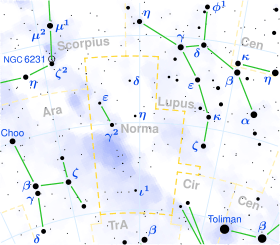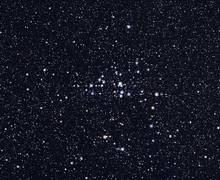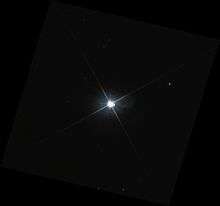S Normae

| |
| Observation data Epoch J2000 Equinox J2000 | |
|---|---|
| Constellation | Norma |
| Right ascension | 16h 18m 51.8325s[1] |
| Declination | −57° 53′ 59.244″[1] |
| Apparent magnitude (V) | 6.394[2] (6.12 - 6.77[3]) |
| Characteristics | |
| Spectral type | F8-G0Ib[3] + B9.5V[4] |
| U−B color index | +0.66[5] |
| B−V color index | +1.00[5] |
| Variable type | δ Cepheid[3] |
| Astrometry | |
| Radial velocity (Rv) | 5.83[6] km/s |
| Proper motion (μ) | RA: 0.07[1] mas/yr Dec.: 0.04[1] mas/yr |
| Parallax (π) | 1.16 ± 0.76[1] mas |
| Distance | 924[2] pc |
| Absolute magnitude (MV) | -4.02[4] |
| Orbit[4] | |
| Period (P) | 8,660 yr |
| Semi-major axis (a) | 794 AU |
| Details[4] | |
| Mass | 6.3 M☉ |
| Radius | 65.6[2] R☉ |
| Luminosity | 3,630 L☉ |
| Temperature | 6,350 K |
| Metallicity | +0.10[7] |
| companion | |
| Mass | 2.4 M☉ |
| Age | 80[8] Myr |
| Other designations | |
| Database references | |
| SIMBAD | data |

S Normae (S Nor) is a yellow supergiant variable star in the constellation Norma. It is the brightest member of the open cluster NGC 6087.
S Normae is a Classical Cepheid variable with a visual magnitude range of 6.12 to 6.77 and a period of 9.75411 days. The spectral type varies during the pulsation cycle from F8 to G0. Its mass has been measured at 6.3 M☉ with reference to a close orbital companion, and it is over 3,000 times as luminous as the sun.
Companions

S Normae is a spectroscopic binary, although the companion has now been resolved using the Hubble Space Telescope Wide Field Camera 3. The separation was 0.90" in April 2011, corresponding to 817 AU. This gives the rare opportunity for a direct determination of the mass of a Cepheid variable star and confirmation of other properties. It is a supergiant that is 6.3 times as massive as the Sun and 2,800 times as luminous. The companion a 2.4 M☉ blue-white main sequence star of spectral type B9.5.[4]
There is a more distant 10th magnitude companion at 30", unsurprising in the centre of an open cluster. It is TYC 8719-794-1, a chemically peculiar A or B class star. Three fainter companions have also been found: a 14th magnitude star at 14"; and two 16th magnitude stars at 20".[9]
References
- 1 2 3 4 5 Van Leeuwen, F. (2007). "Validation of the new Hipparcos reduction". Astronomy and Astrophysics. 474 (2): 653. arXiv:0708.1752
 . Bibcode:2007A&A...474..653V. doi:10.1051/0004-6361:20078357.
. Bibcode:2007A&A...474..653V. doi:10.1051/0004-6361:20078357. - 1 2 3 Moskalik, P.; Gorynya, N. A. (2005). "Mean Angular Diameters and Angular Diameter Amplitudes of Bright Cepheids". Acta Astronomica. 55: 247. arXiv:astro-ph/0507076
 . Bibcode:2005AcA....55..247M.
. Bibcode:2005AcA....55..247M. - 1 2 3 Samus, N. N.; Durlevich, O. V.; et al. (2009). "VizieR Online Data Catalog: General Catalogue of Variable Stars (Samus+ 2007-2013)". VizieR On-line Data Catalog: B/gcvs. Originally published in: 2009yCat....102025S. 1. Bibcode:2009yCat....102025S.
- 1 2 3 4 5 Evans, Nancy Remage; Bond, Howard E.; Schaefer, Gail H.; Mason, Brian D.; Karovska, Margarita; Tingle, Evan (2013). "Binary Cepheids: Separations and Mass Ratios in 5M ⊙ Binaries". Astronomical Journal. 146 (4): 93, 10 pp. arXiv:1307.7123v1
 . Bibcode:2013AJ....146...93R. doi:10.1088/0004-6256/146/4/93.
. Bibcode:2013AJ....146...93R. doi:10.1088/0004-6256/146/4/93. - 1 2 Ducati, J. R. (2002). "VizieR Online Data Catalog: Catalogue of Stellar Photometry in Johnson's 11-color system". CDS/ADC Collection of Electronic Catalogues. 2237. Bibcode:2002yCat.2237....0D.
- ↑ Mermilliod, J. C.; Mayor, M.; Udry, S. (2008). "Red giants in open clusters. XIV. Mean radial velocities for 1309 stars and 166 open clusters". Astronomy and Astrophysics. 485: 303. Bibcode:2008A&A...485..303M. doi:10.1051/0004-6361:200809664.
- ↑ Klagyivik, P.; Szabados, L. (2009). "Observational studies of Cepheid amplitudes. I. Period-amplitude relationships for Galactic Cepheids and interrelation of amplitudes". Astronomy and Astrophysics. 504 (3): 959. arXiv:0908.3561
 . Bibcode:2009A&A...504..959K. doi:10.1051/0004-6361/200811464.
. Bibcode:2009A&A...504..959K. doi:10.1051/0004-6361/200811464. - ↑ Netopil, M.; Paunzen, E.; Heiter, U.; Soubiran, C. (2016). "On the metallicity of open clusters. III. Homogenised sample". Astronomy & Astrophysics. 585: A150. arXiv:1511.08884
 . Bibcode:2016A&A...585A.150N. doi:10.1051/0004-6361/201526370.
. Bibcode:2016A&A...585A.150N. doi:10.1051/0004-6361/201526370. - ↑ Evans, Nancy Remage; Bond, Howard E.; Schaefer, Gail H.; Mason, Brian D.; Tingle, Evan; Karovska, Margarita; Pillitteri, Ignazio (2016). "Hubble Space Telescopesnapshot Survey for Resolved Companions of Galactic Cepheids". The Astronomical Journal. 151 (5): 129. arXiv:1603.02224
 . doi:10.3847/0004-6256/151/5/129.
. doi:10.3847/0004-6256/151/5/129.